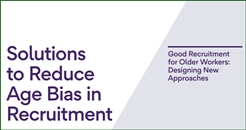 Tools to reduce age bias in recruitment
Tools to reduce age bias in recruitment
From a report by the Behavioural Insights Team
Older workers (defined as aged 50 and over) make up approximately one third of the workforce, yet face numerous disadvantages during the recruitment process. These disadvantages were exacerbated during and after the pandemic.
The number of older workers seeking unemployment related benefits doubled during lockdown and analysis of the labour market in 2020 found that older workers who were unemployed were far more likely to have been out of work for more than 12 months compared to younger adults.
It is likely that some of the disadvantages that older workers face are related to age bias and age-related stereotypes.
Research suggests that few employers and recruiters perceive age diversity to be an issue or adopt approaches to debias their recruitment processes for older workers. More specifically, the design of job adverts, such as job criteria like organisational ‘fit’, or the language used in adverts, may deter older workers from applying in the first place, while unstructured interview or selection processes may make it more likely that age bias or personal preferences can influence the hiring decision.
Importantly, older workers share this perception of age bias. A survey found that one third of older workers thought that they have been rejected because of their age.
The Behavioural Insights Team have helped co-design, test and develop three tools to minimise age bias in the recruitment process which employers and recruiters can use. These are:
-
A job advert template which aims to help employers and recruiters create new job adverts or adapt their current ones. The template combines multiple approaches to reduce age bias, including setting a part-time/job share default, removing biased language and including workplace adjustments amongst others.
-
An interview invitation template and scheduling and adjustments form which aims to provide applicants with timely guidance on the interview, make it easier to schedule a time that works for them, and support them to feel more comfortable asking for adjustments to the recruitment process. It also makes scheduling and providing adjustments easier for employers. Although being older doesn’t necessarily mean you will have a health issue, this disproportionately supports older workers as they are more likely to have health conditions and/or be disabled.
-
Guidance on how to talk about flexible working during recruitment which aims to reduce discrimination against applicants asking for flexibility by providing succinct guidance on considering flexibility in job design, transparently advertising flexibility and when to raise it with candidates. This is likely to benefit older workers as they are more likely to work part-time and wish to work fewer hours than they currently do.
They have been user-tested with employers, recruiters and older workers, but how they impact outcomes in the real world, such as rates of applications from older workers or hiring success, has not yet been tested but this is planned. Why not use in any case?
See the full article here.
Retweet about this article:
From a report by the Behavioural Insights Team, 25/10/2023